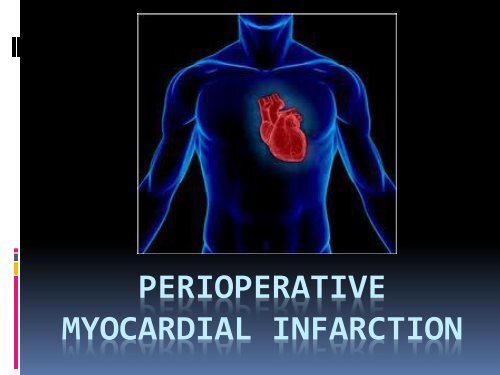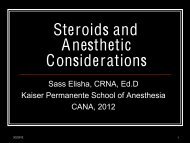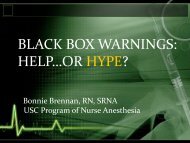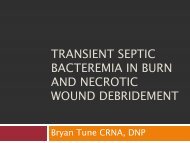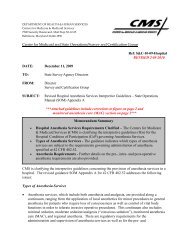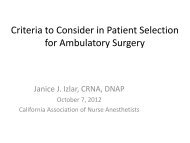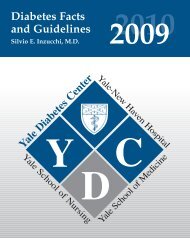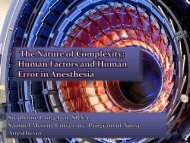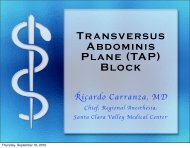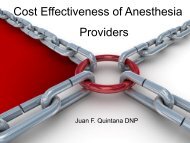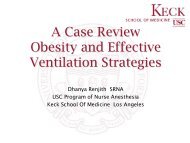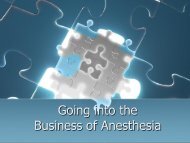Perioperative Myocardial Infarction
Perioperative Myocardial Infarction
Perioperative Myocardial Infarction
Create successful ePaper yourself
Turn your PDF publications into a flip-book with our unique Google optimized e-Paper software.
PERIOPERATIVEMYOCARDIAL INFARCTION
PRESENTED BY:Shelly Noland SRNA• Co-Edited by: Jen Thompson CRNA Sass Elisha CRNA EdD Becky Ashlock CRNA Katie Tipton SRNA Mona Man0sori SRNA
Objectives• Examine prevalence and etiology ofintraoperative MI• Discuss risk factors for intraoperative MI• Discuss preoperative and intraoperativeanesthetic management of those at risk
Clinical Problem• 500,000 - 900,000 periop MIs annually 40 to 70% associated mortality rates• 50% of intraop deaths are cardiac related• Difficult to diagnose in the anesthetized inability to report or see S&S Monitoring interference.
Additional Risk factors• High risk = Kidney transplantation, shortstature, low BMI (24-45 % mortality)• High risk to moderate = Endocarditis,cardiogenic shock, COPD, anemia, poornutrition, liver disease• Moderate risk = Obstetrics, laparoscopic,neurosurgery, steroid use, bleeding disorders
ANESTHETIC RISK FACTORSSNS stimulation Induction/Laryngoscopy Surgical incision/Pain Volume overload Hypertension Hypotension Hypovolemia/Anemia Tachycardia/arrhythmiaCatecholamines Positioning Light Anesthesia Hypothermia Hypoxia Drugs/Reaction Emergence
Preoperative Assessment• Six step method evaluates: Urgency of surgery/Risk of Surgery Active cardiac evaluation Previous cardiac intervention Identification of major clinical predictors Decision for further testing/intervention Development of anesthetic plan.
Risk Assessment ToolsGOLDMAN CARDIAC RISK INDEX (Fleisher et al., 2007)1. History 2. Cardiac Exam 3. ECG 4. Generalmedicalconditions5. Operationage greater than70 years(5 points)MI within 6months(10 points)Signs of CHF(11 points)SignificantAortic Stenosis(3 points)Arrhythmia(7 points)5 or more PVC’sper minute(7 points)PO2 < 60; PCO2> 50; K < 3; HCO3< 20; BUN > 50;Creat > 3;elevated SGOT;chronic liverdisease;bedridden(3 points)Emergency(4 points)IntraperitonealIntrathoracic,aorticprocedures(3 points)Cardiac Event Risk Index0-5 points: 1% 6-12 points: 7% 12-25 points: 14% 26-53 points: 78%
Intraoperative Diagnostics• Diagnostic monitors: TEE, Troponin I, 5-lead & 12-lead ECG, Swan Gantzcatheter, and Vigeleo.• ECG Lead-V5 =89% detection of MI Lead II and V5 = 96% Lead s III, aVR & V3-V6 + II &V is 100% Diagnostic mode for ischemic monitoring
Etiology• Anesthesia + surgery = enormous, unpredictableand unphysiologic alterations on the body• Imbalance of Supply and Demand Mechanism 1 = ↑ catecholamine & stress hormonerelease: ↑ BP/↑ HR, ↑ free fatty acids, ↑insulindeficiency, coronary artery sheer, vasospasm, plaquerupture leading to acute coronary thrombosis. Mechanism 2 = systemic inflammation,hypercoagulation, hypoxia and high stress.
Etiology• Surgically induced Proinflamatory responses: Release of cytokines Hypercoagulability Fibrinolytic activity Endothelial dysfunction Atherosclerotic plaque instability Hemodynamic changes SNS stimuli and painful stimuliISCHEMIA!!!!!!!!!
Etiology• Pro-inflammatory response more likely to because a cardiac event than the patient’sunderlying cardiac status• Autoregulation impaired under anesthesia &altered in patients with CAD
Signs and Symptoms• Hemodynamic: instability of HR/BP, desaturation, shock refractory tovasopressors/vasodilators, poor perfusion, new murmur,skin discolored, pulm edema• ECG: LBBB, arrhythmias, ST changes, T wave inversion, QRS &T wave axis deviations, and R/U wave changes• Labs: elevated lactate, CK, myoglobin & Troponin levels
Monitoring Interference• Interference Problems Patient positioning Inadequate lead placement Electrocautery• 75% of Intraop MIs are Silent, present atypically,w/o ST changes, Q waves or chest pain.• St depression will be 1mm or less in anesthetized
Differential Diagnosis• MI may present with signs alike manyother conditions: malignant hyperthermia pain anaphylaxis pulmonary embolism Shock/hemorrhage.
Preoperative Management• Stress testing: Dobutamine Echo• Stents/CABG Clinical evidence supports reduction in intraopischemia events• Beta blockers• Statins• Retrospective Study No cardio-protective meds = 11% mortality rate Statin & beta blocker therapy 3% mortality rate
Intraoperative Prevention• Maintain a Balanced Supply and Demand: Avoid mechanical, metabolic & electrophysiologicalterations Maintain Low HR
Intraoperative Management• 100% O2 & Meds:BBCCBAlpha blockersVasodilators/nitratesGAS/NarcoticsLAAntiplt drugs• TEE, Cardiac enzymes, 12 lead (may be inaccurate)Sequential monitoring of cardiac troponin-I provides bestdetection intra and post op MI.
BETA BLOCKERS• BB: Use in high risk patients only w/ CAD or2+ cardiac risk factors Reduces morbidity, but not mortality Only 30% of pts prescribed benefit from therapy• Contraindicated: Asthma, COPD, Heartblocks, Severe LV dysfnx, Bradycardia
MEDICATIONS• CCB: Use if BB contraindicated or CA spasm No supportive evidence, avoid in Heart blocks• ACE INH: Use for HTN uncontrolled intraop Reduces ischemia but not mortality• Nitrates: Use for suspected ischemia Avoid in hypotension/hypovolemia
Impending Cardiogenic Shock• Early Cardiology Consult when ischemiaidentified• Balloon Pump• Cardiac Cath• CABG
Postoperative Management• Adequate pain control• Low Stress environment• Hemodynamic Stability• Continue IV/PO beta blockers• O2 supply and Demand balanced
Postop Management• Catecholamine levels strikingly elevated aftersurgery, platelets activated, pain, fluid shifts& bleeding: further risk for ISCHEMIA!• Post op MI’s also silent, painless• Cornell Study: Esmolol gtt started preop,continue 48 hours post op: reducedincidences of ischemia in postop period
Additional Literature• Preop LVH: highly associated w/intraop ischemia• Preop Dig: associated w/intraop Vtach• Future research aimed at mimicking ischemicpreconditioning to reduce intraop infarction• Combined GA + RA less risk of thrombolic events
Conclusions• Anesthetists must be able to: identify patients at risk know the associated etiology and S &S be able to apply diagnostic measures to yieldaccurate diagnosis. Minimize physiologic alterations and stress• Incidences of intraoperative MI’s havedecreased but mortality rates associatedhave not!
Conclusions• If you want to get rich, find out how todecrease incidences/severity of MIs by: Develop cardio-protective medications Create less invasive procedures Design monitoring resistant to interference Develop stress reducing anesthetic techniques
Forget everything already???• Look for: Ectopy Rhythm change• Run 12 lead & Send troponin• 100% 02, Aspirin/BB/CCB/nitrate• Aim for HR < 70, normotensive• Notify surgeon• Determine Cause (Anemia, embolism, Etc.)
THE END
REFERENCES• Adesanya, A., de Lemos, J., Grelich, N., & Whitten, C.(2005). Management of <strong>Perioperative</strong> <strong>Infarction</strong> inNoncardiac Surgical Patients. CHEST, 130, 584-596.• Feringa, H., Bax, J., Boersma, E., Kertai, M., Mejj, S., Galal,W., & Schouten, O. (2006). High Dose B-Blackers and TightHeart Rate Control Reduce <strong>Myocardial</strong> Ischemia andTroponin T Release in Vascular SurgeryPatients. Circulation, 114, 344-349.• Lindenauer, P., Pekow, P., Wang, K., Mamidi, D., Guiterrez,B., & Benjamin, E. (2005). <strong>Perioperative</strong> Beta-BlackerTherapy and Mortality after major Noncardiac Surgery. TheNew England Journal of Medicine, 353, 61-349.• Monk, T., Saini, V., Weldon, B., & Sigl, J. (2005). AnestheticManagement and One-Year Mortality After NoncardiacSurgery.Anesth Analg, 100, 4-10.
REFERENCES• Dawood, M., Gupta, D., Southern, J., Walia, A., Atkinson, J., & Dagel, K. (1996).Pathology of fatal perioperative myocardial infarction: implications regardingpathophysiology and prevention. international journal of cardiology, 37-44.• Urban, M., Markowitz, S., Gordon, M., Urquhart, B., & Kligfield, P. (2000).Postoperative Prophylactic Administration of B-Adrenegergic Blockers inPatients at Risk for <strong>Myocardial</strong> Ischemia. Society of cardiovascularAnesthesiologists: Anesthe Analg, 90, 61-1257.• Landesberg, G., Mosseri, M., Wolf, Y., Vesselov, Y., & Weissman, C. (2002).<strong>Perioperative</strong> <strong>Myocardial</strong> Ischemia and <strong>Infarction</strong>. Anesthesiology, 96, 70-264.• Eagle, K., Challman, B., & Brundage, B. (2002). Guidelines for <strong>Perioperative</strong>Cardiovascular Evaluation for Noncardiac surgery [Editorial]. American College ofCardiology/American Heart Association task Force on practice guidlines, 93(27).• Mangano, D., Browner, W., Hollenberg, M., London, M., Tubau, J., & Tateo, I.(1990, December 27). Association of perioperative myocardial ischemia withcardiac morbidity and mortality in men undergoing noncardiac surgery. The NewEngland Journal of Medicine, 323(26).• Wartier, D., Pagel, P., & Kersten, J. (2000). Approaches to the Prevention of<strong>Perioperative</strong> <strong>Myocardial</strong> Ischemia.Anesthesiology, 92, 9-253.
REFERENCES• Barash, P. G., Cullen, B. F., Stoelting, R. K., Cahalan, M. K., & Stock, M. C.(2009). Clinical Anesthesia (6th ed., pp. 121-123). Philadelphia, PA: LippincottWilliams & Wilkins.• Dahlin, L. G., Olin, C., & Svedjeholm, R. (2000, October). <strong>Perioperative</strong>myocardial infarction in cardiac surgery--risk factors and consequences. A casecontrol study. Scandinavian Cardiovascular Journal, 34(5), 7-522. RetrievedJanuary 30, 2012, from PubMed (11191945).• Devereaux, P., Goldman, L., Cook, D. J., Gilbert, K., Leslie, K., & Guyatt, G. H.(2005, September). <strong>Perioperative</strong> cardiac events in patients undergoingnoncardiac surgery: a review of the magnitude of the problem, thepathophysiology of the events and methods to estimate and communicate risk[Electronic version]. Canadian Medical Association Journal, 173(6), 627-634.doi:10.1053/cmaj.050011• Fleisher, L., Beckman, J., Brown, K., Calkins, H., Chaikof, E., Fleischmann, K., etal. (2007, September). ACC/AHA 2007 Guidelines on <strong>Perioperative</strong> CardiovascularEvaluation and Care for Noncardiac Surgery : A Report of the American College ofCardiology/American Heart Association Task Force on Practice Guidelines.Circulation: A Journal of the American Heart Association, 116, 418-50.doi:10.1161/CIRCULATIONAHA.107.185699
REFERENCES• Hines, R. L., & Marschall, K. E. (2008). Stoeltings's Anesthesiaand Co-Existing Disease (5th ed., pp. 5-25). Philadelphia, PA:Churchill Livingstone.• Martinez, E. A., Nass, C. M., Jermyn, R. M., Rosenbaum, S. H.,Akhtar, S., & Chan, D. et al. (2005, October). IntermittentCardiac Troponin-I Screening is an Effective Means ofSurveillance for a <strong>Perioperative</strong> <strong>Myocardial</strong> <strong>Infarction</strong>. Journalof Cardiothoracic and Vascular Anesthesia, 19(5), 577-582.doi:10.1053/j.jvca.2005.07.002• Park, K. W. (2002). Intraoperative Management of the CardiacPatient in Noncardiac Surgery [Editorial]. InternationalAnesthesiology Clinics, 40(1), 1-143.• Priebe, H. J. (2004, April 19). Triggers of perioperativemyocardial ischaemia and infarction. British Journal ofAnaesthesia,93(1), 9-20. doi:10.1093/bja/aeh14


